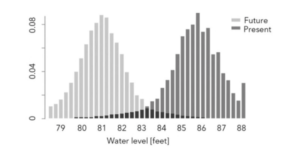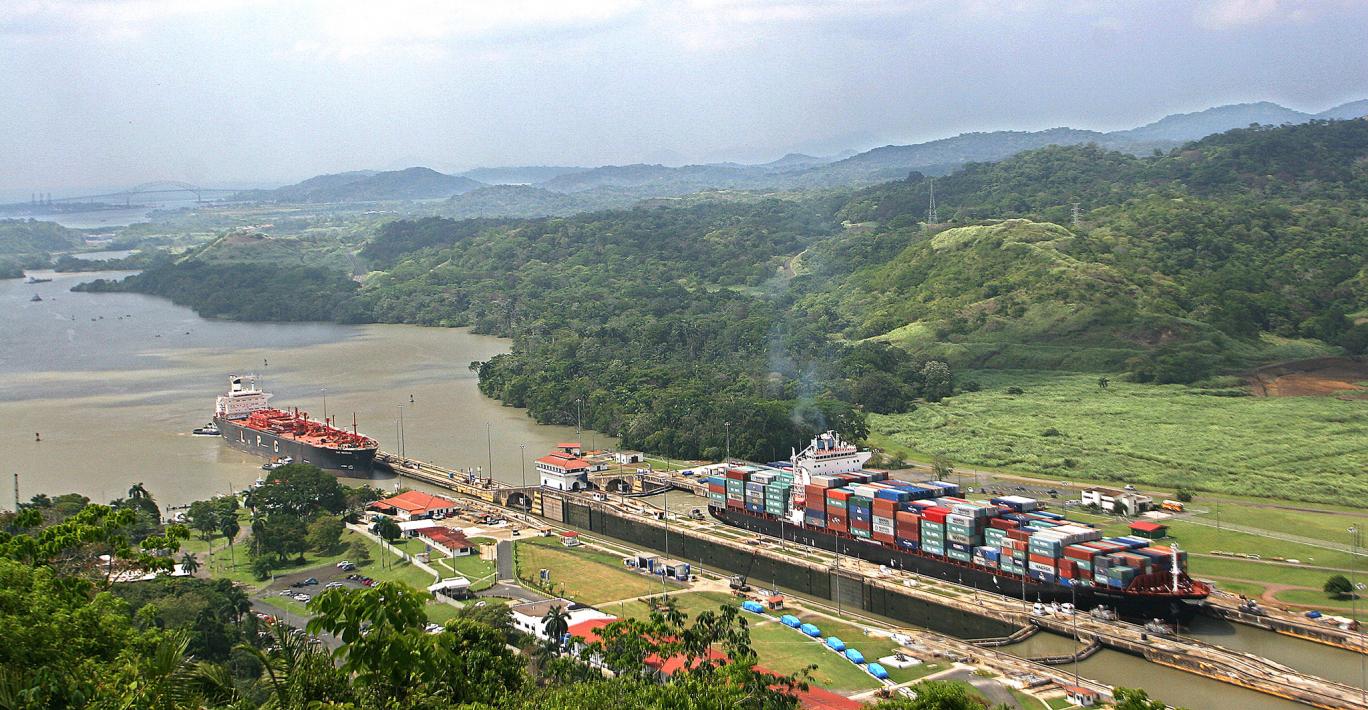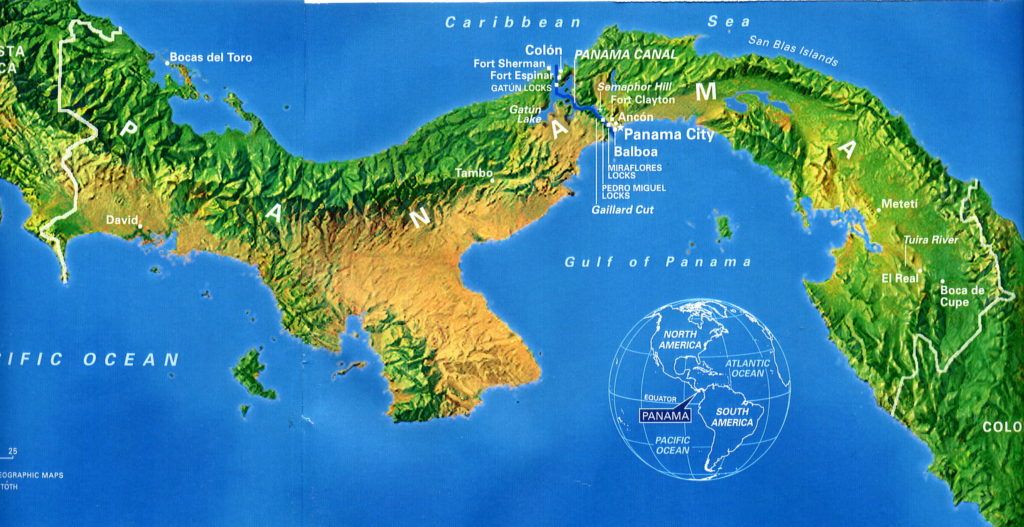The Panama Canal: The “Bottleneck” of Global Shipping?

The Impact of Climate Change on the Panama Canal and its Viability as a Global Shipping Route.
Since its completion in 1914, the canal has been one of the most important international waterways, handling approximately five percent of world trade. To put things in perspective, an average of 34 ships go through the canal every day, and it takes 52 million gallons of water (roughly 82 Olympic-sized swimming pools) to move each ship through. This summer (2016), a $5.4 billion dollar expansion project was completed following nine years of dredging, land-blasting, and 16 100-ft tall sluice gates for the canal’s locks. “We knew for a long time we had to think about expanding, otherwise we would lose relevancy in the world,” said Ilya R. Espino de Marotta, who oversees the project for the Panama Canal Authority, an autonomous agency of the government of Panama.[1]
However, the relevancy of the canal lies in question due to climate change, which could negatively affect both the Panamanian economy and the efficiency of global supply chains. Extreme weather conditions that lead to floods and droughts could pose a huge risk to the consistent water supply the canal operates on.
The expanded canal promises improved shipping options for global manufacturers, retailers, and shippers, enhanced logistics, maritime service and supply-chain reliability. The project has not been anything short of colossal with the construction of a new set of locks on the Atlantic and Pacific sides of the waterway that create a third traffic lane that doubles cargo capacity on the canal. But the expanded canal survive the threat of climate change?



The World Bank found that between 1982-2008, Panama suffered 32 natural disasters that cost the country $86 million.[2] Beyond the obvious threats to human and ecological systems in the region, the risk of global warming also affects shipping traffic on the Canal. In August 2015, as a result of El Niño (which causes sea surface temperatures in the eastern Pacific to rise) ship traffic was restricted for 20% of the 14,000 shops that travel through the waterway annually. The Panama Canal has been a central node for world trade, facilitating more than 300 million tons of products every year between the Atlantic and the Pacific oceans[3], but events such as this could lead to Central America and the Panama Canal becoming a less reliable passageway for vessels. On a larger level, sever restrictions on the use of the canal could put pressure on transport systems that would undoubtedly lead to changes in global supply chain patterns going forward.
“Climate change will lead to reduced river flows or lake levels in some areas with severe implications for navigation and port access. Increased shipping or improved inland transportation in areas where higher temperatures will increase ice-free periods is likely to benefit some ports. For instance, the opening of the Northwest Passage could provide a commercial alternative to using the Panama Canal, which would decrease shipping movements in Central America.”[4]

The Panama Canal Authority has already taken steps towards using water efficiently and sustainably – the canal expansion project has reduced overall water use by 7 percent. “For Panama, it’s extremely critical to have a sustainable management of water resources throughout the basin of the Canal, particularly in the section that maintains appropriate water levels in Gatun Lake,” said Mr Ricardo Mena, head of the Regional Office for the Americas of the United Nations Office for Disaster Risk Reduction (UNISDR).[5]
Beyond water management policies, the Panamanian President, Juan Carlos Varela confirmed Panama’s commitment to Sustainable Development Goals (SDG’s) and the 2030 UN Sustainable Development Summit’s agenda. The Panamanian government needs to take a stronger stance on sustainability and consider the long-term implications of climate change on the canal more seriously, rather than focus on short-term profitability for the private sector.
This week, the Panama Canal Authority launched the Environmental Premium Ranking to rewards shippers with vessels that meet high environmental efficiency standards starting January 1, 2017. “With the addition of the Environmental Premium Ranking to our Recognition Program, we’re rewarding those who make conscious efforts to reduce greenhouse gas emissions and invest in technology that will make shipping even more efficient,” said Panama Canal Administrator Jorge L. Quijano. Initiatives such as this are steps in the right direction for the Panama Canal.
Word Count: 780
[1] McDonnell, Patrick J. and Natalie Kitroeff. “$5.4-Billion Expansion of Panama Canal Could Reshape World Trade Routes”. Los Angeles Times 2016. Web.
[2] The World Bank,. Panama, Impacts And Vulnerabilities. Climate Change Knowledge Portal, 2016.
[3] Panama Canal Expansion Study. U.S. Department of Transportation – Maritime Association, 2013. Print. Developments In Trade And National And Global Economies.
[4] Ng, Koi Yu Adolf et al. Climate Change And Adaptation Planning For Ports. New York: Routledge, 2016. 159.
[5] “Easing Impact of Drought On The Panama Canal – UNISDR”. Unisdr.org.



Interesting read. Like you mentioned, poor water usage is only part of the problem that is rising from climate change and the increase in oceanic trade. There is also severe biological risk that can arise from the transportation of invasive species in ballast water from ships. Hopefully the government is also keeping its eyes open to that possible threat.
Very interesting post – a topic I wouldn’t have thought to be related to climate change. I didn’t think that the ability to operate the canal could potentially be compromised by the unavailability of water. I also liked how you posted a few pictures to visualize the canal, and how you described the significance of the canal for world trade in numbers, at the beginning of your post. I also found it interesting that you brought up the Northwest Passage (i.e. the sea route north of Canada, connecting the Atlantic and Pacific Ocean via the Arctic) – I didn’t know that was a potential opportunity for cargo and shipping, and that it could be used as an alternative to the Panama canal; another impact of global warming & rising sea levels that I wouldn’t have expected. Also, it seems that certain cargo ships and cruise ships will still be too large to fit through the canal [1], so maybe another expansion will be necessary in the future.
[1] Wikipedia. 2016. Panamax – Wikipedia. [ONLINE] Available at: https://en.wikipedia.org/wiki/Panamax. [Accessed 06 November 2016].
Excellent post – the Panama Canal is a topic which has long interested me: I used to work in a port terminal, and many of our investments and projections considered the Canal’s expansion. One topic that always worried us was the extreme weather conditions the region faces, such as the floods and droughts you mentioned. Seeing the pictures you posted and having briefly studied the topic of climate change, I wondered if the Canal’s Authority / Panamanian Government is acting to prevent and/or compensate deforestation in any way. The Canal is surrounded by a beautiful tropical forest, which may very well help carbon capturing and and protect the watershed.
Great post Dori! I didn’t know that climate change could end up creating a bottleneck at the Panama canal and essentially disrupt worldwide shipping lines. Given the importance of the canal to the country’s economy, I’m somewhat surprised that the government hasn’t made more of an effort to combat climate change. Ships are responsible for 2-3% of the heat-trapping carbon dioxide released each year and their emissions may grow by 50%-250% percent by 2050 [1]. I wonder if the Panamanian government can institute certain limitations on ships that pass through the canal – e.g. a law that states that ships have to comply with certain fuel standards and cannot discharge garbage into the ocean. I assume this would be difficult to implement though so perhaps the government could consider coordinating with other countries and establishing new standards to combat the polluting impacts of ships.
[1] http://grist.org/climate-energy/shipping-industry-climate-change-whats-the-big-rush/
This is really interesting. I didn’t notice that Panama canel will be influenced so heavily by global warming. And the area around Panama Canel are really precious that we all have to help preserve. However, this can’t not be solved by the government of Panama sololy. Is it possible that the Panama government impost more green tax in all the ships and use these funds to reserve the area around the Canel? Thank you for your sharing!
You touched on an issue that I’m super interested – that of alternative shipping through the Northwest Passage. (https://www.washingtonpost.com/news/energy-environment/wp/2015/09/10/why-the-northwest-passage-probably-wont-be-ready-for-shipping-any-time-soon/).
The Panama canal was developed as an alternative the failure to find the Northwest Passage – which never really existed until now. While it seems that for now that shipping route isn’t a viable alternative, the pain felt by southern routes likely means that the planet is heating further, and northern routes will continue to open up more as ice melts.
In addition to business concerns, there are a number of geo-political concerns that come with this shift in global commerce. The Panama canal is one of the safer routes of transit in the world, thanks to Panama’s position as a peaceful nation, and protection from the U.S. The Northwest passage passes between Russia and Alaska, and opens potential for new conflict as Arctic nations fight to gain control over shipping routes, and Arctic oil. Something to keep an eye on…
Thanks for writing this post Dori. I am shocked by how climate change may put at risk the operations of a megaproject as big as the Panama Canal. After reading your post, I have a couple of reactions:
– It seems like the Canal authorities started looking for initiatives after they had finished the expansion of the channel. However, it would be interesting to see if they considered engineering/design alternatives to adapt to climate change (e.g., a design that would require less water to operate). I ran a quick google search about it, without results, which surprises me.
– It is amazing that they could reduce their water usage by 7% in such a short time. This makes me wonder if there are any additional efficiency operational levers to be pulled in the Canal.
– I like their idea to have everybody involved in the challenge by incentivizing environmentally friendly shippers, which makes me wonder: should every country put in place the same kind of incentives for their trade partners?
Really interesting analysis! I think you raise some great points on how the Panama Canal may be impacted by climate change. I appreciate how you brought up some of the alternatives to the Panama Canal such as the Northwest Passage. Since the impacts of climate change may differ on a regional basis, another interesting analysis may be to look at how the Panama Canal may be impacted by climate change relative to some of the other shipping options. Are other shipping routes impacted by climate change and if so, is it possible that adverse weather conditions on other routes may drive traffic to the Panama canal? Also, you mention the Northwest Passage, but is this really a viable option to the Panama Canal for shipping companies? I hadn’t considered it before, but the article below discusses some political disputes around the Northwest Passage and references a lack of investment in the route. Is it possible, that given the recent investments in the Panama Canal plus adverse weather conditions in other parts of the world, it could remain an attractive route for the foreseeable future?
“How the Arctic Ocean could transform world trade”
http://www.aljazeera.com/indepth/opinion/2013/08/201382273357893832.html
Great post Dori! Having come from a global supply chain background and understanding the importance and complexity of cargo vessels and their routes, I found this very interesting. However, I had no idea that the area was facing such potentially devastating implications due to climate change. This post makes me wonder how the effects of climate change were considered in the initial proposals and planning of the panama expansion project. Recognizing these implications now, I would think that many of these same challenges must have been considered throughout the initial proposal process. It would be really interesting to learn more about how such challenges were taken into effect when green lighting the project and making the decision to break ground on such a massive investment.
In addition it would be interesting to take a look at what environmental trade offs were consciously made when approving the project. On the other hand, it would also be fascinating to understand how this project could positively impact the climate change problem our world faces. Does this expansion project provide more efficient trade routes, or allow for wider more energy efficient vessels?
I like this post because it touches the topic of long term vs short terms goals and implications. I believe that the only way to solve the climate crisis is for companies, individuals and governments to focus on the LONG-TERM implications of climate and not on the short-term incentives of profit or political gain. Past fail policies have had one or both of these issues as root causes. The Panama Canal Authority is doing a great job to tackle its water management crisis with a long-term strategy. Other governments and businesses should follow its path and only then we will get on track to solving climate change.